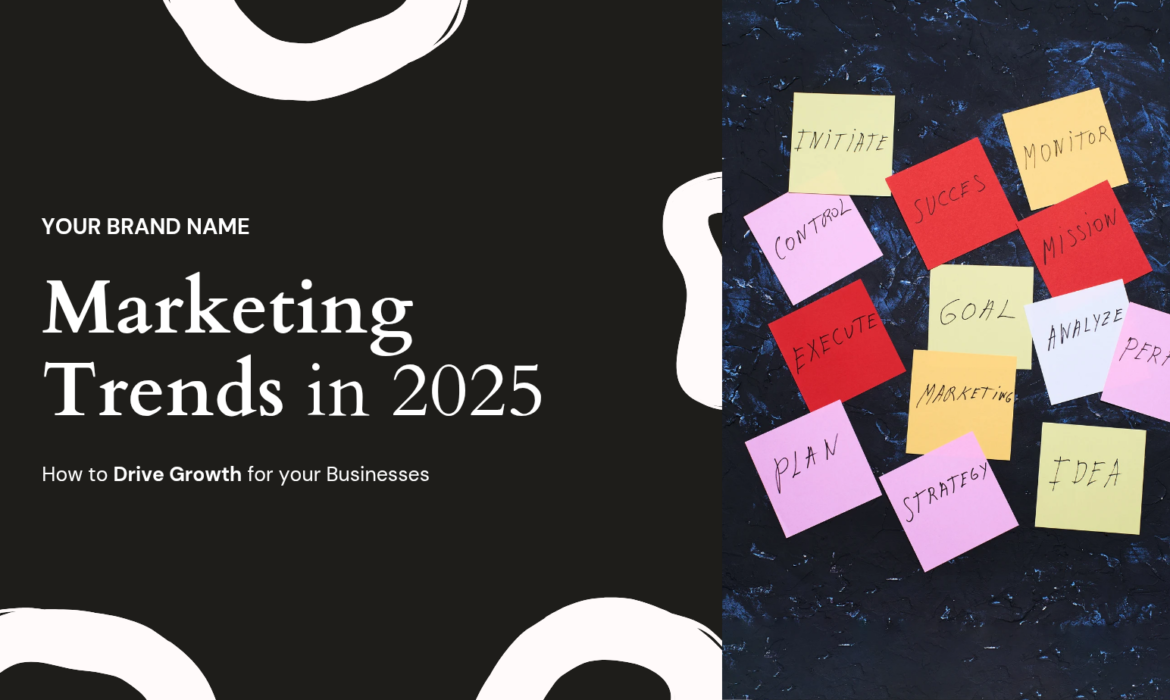081-4797-7173
Over the years, we’ve seen shifts in the way companies approach marketing, from the advent of social media to the rise of data-driven campaigns. As we look forward to the happenings in 2025, it’s clear that the marketing landscape will continue to transform at an unprecedented pace.
The question is: how can your business stay ahead and drive growth in an increasingly competitive and digital-first world?
In 2025, staying relevant will require you to adopt emerging trends that resonate with modern consumers. As technology continues to advance and consumer expectations evolve, companies must be agile, forward-thinking, and ready to capitalize on the latest marketing innovations. From the integration of artificial intelligence (AI) and voice search optimization to the rise of hyper-personalized experiences and immersive technologies like augmented reality (AR) and virtual reality (VR), the marketing trends in 2025 offer new opportunities to engage audiences, build brand loyalty, and drive sales.
In this article, we will explore the key marketing trends that will dominate in 2025 and how your business can leverage these trends to grow.
Key Marketing Trends in 2025
As you gear up your business for success in 2025, staying ahead of marketing trends will be crucial for maintaining a competitive edge. The following key trends are expected to dominate the marketing landscape and play a significant role in driving growth for businesses of all sizes:
1. AI and Automation in Marketing
Artificial intelligence (AI) and automation are no longer futuristic concepts; they are the backbone of many modern marketing strategies. In 2025, businesses will increasingly rely on AI-driven tools to enhance customer engagement, optimize campaigns, and streamline operations. AI can assist in everything from content creation to personalized recommendations and predictive analytics, allowing businesses to create more relevant and timely interactions with their audience. Automation, on the other hand, enables businesses to scale their efforts without sacrificing personalization. By automating tasks such as email marketing, social media posting, and customer support, companies can free up valuable time and resources to focus on strategic initiatives.
- Personalization: AI allows for a higher level of personalization by analyzing customer data and delivering tailored experiences, from product recommendations to dynamic pricing.
- Efficiency: Automation reduces manual work, improves response times, and increases marketing efficiency, helping businesses manage large-scale campaigns with ease.
2. Voice Search Optimization
The proliferation of smart speakers, voice assistants, and voice-enabled devices is reshaping the way people search for information online. In 2025, voice search is expected to account for an even larger portion of all search queries. Businesses must adapt their SEO strategies to optimize content for voice searches, which are often longer, more conversational, and focused on local intent. For example, consumers may use voice search to ask specific questions like “Where can I find the best pizza near me?” or “How do I fix a leaky faucet?” Businesses that can align their content with these natural, spoken queries will stand out in voice search results.
- Long-Tail Keywords: Voice searches typically involve more natural, question-based phrases, so businesses must optimize content with long-tail keywords that reflect conversational language.
- Local SEO: Voice searches are often location-based, making local SEO efforts even more critical in reaching the right customers at the right time.
3. Hyper-Personalized content
Consumers today expect more than just generic, one-size-fits-all marketing—they want experiences tailored to their preferences, behaviors, and needs. By 2025, hyper-personalization will become a central focus for businesses looking to drive deeper engagement and loyalty. Using data-driven insights, businesses will be able to deliver highly customized content, products, and services that make each customer feel like they are the only one. Whether it’s through personalized email campaigns, targeted social media ads, or customized website experiences, hyper-personalization helps businesses forge stronger connections with their audience.
- Customer Data: By analyzing customer data such as browsing behavior, purchase history, and social media interactions, businesses can craft highly targeted marketing messages.
- Enhanced Customer Experience: Tailored content and offers help enhance the customer experience, improving satisfaction and increasing the likelihood of conversions.
4. Video Marketing Dominance
Video continues to reign supreme as one of the most engaging forms of content. In 2025, video marketing will dominate the digital landscape, with short-form videos, live streaming, and interactive video content taking center stage. Consumers are more likely to engage with and share videos compared to other types of content, making video a powerful tool for building brand awareness, educating customers, and driving sales. Social media platforms like TikTok, Instagram, and YouTube will remain key drivers of video consumption, with brands using these platforms to reach and interact with their audiences in creative ways.
- Short-Form Video: The growing popularity of short-form video content; especially on platforms like TikTok and Instagram Reels presents an opportunity for businesses to create quick, attention-grabbing messages that resonate with their audience.
- Live Streaming: Live streaming allows businesses to engage with their audience in real-time, creating authentic connections, answering questions, and showcasing products or services in action.
5. Social Commerce and Shoppable Content
Social commerce, the ability to buy products directly through social media platforms, is set to continue its rapid growth in 2025. Platforms like Instagram, Facebook, and TikTok already allow users to make purchases without ever leaving the app, and this trend will become even more prominent. Brands will increasingly integrate shoppable features into their content, allowing customers to browse, shop, and checkout seamlessly within social platforms. Influencer marketing will also play a significant role in driving social commerce, with influencers promoting products in an authentic, relatable manner that encourages followers to make a purchase.
- Seamless Shopping Experience: By offering a seamless, in-app shopping experience, businesses can reduce friction and increase conversion rates, providing a more convenient way for consumers to make purchases.
- Influencer Partnerships: Partnering with influencers who align with your brand can help you reach a wider audience and drive sales through social commerce.
6. Sustainability and Purpose-Driven Marketing
As consumers become more conscious of environmental and social issues, businesses must demonstrate their commitment to sustainability and social responsibility. In 2025, purpose-driven marketing will be a key factor in consumer decision-making. Brands that prioritize sustainability, ethical sourcing, and social impact will resonate with today’s value-driven consumers. Authentic storytelling about a brand’s mission and the positive impact it has on the world can help build trust and loyalty.
- Transparency: Consumers want to know the truth about how products are made, where materials come from, and how brands are contributing to social and environmental causes.
- Brand Values: Brands that align their messaging with their core values, such as sustainability and inclusivity, will be better positioned to connect with customers who share similar beliefs.
7. Augmented Reality (AR) and Virtual Reality (VR)
In 2025, AR and VR will become more accessible and integral to creating immersive, interactive marketing experiences. These technologies allow businesses to engage customers in new and exciting ways, such as offering virtual try-ons, immersive product demonstrations, and interactive virtual events. By leveraging AR and VR, brands can provide customers with experiences that feel personal and memorable, ultimately increasing engagement and driving sales.
- Virtual Try-Ons: AR can allow consumers to try on products such as clothing, accessories, or makeup virtually, enhancing the shopping experience.
- Immersive Experiences: VR can create fully immersive brand experiences, giving customers a chance to experience a product or service in a way that traditional marketing methods cannot replicate.
In 2025, these marketing trends will reshape how businesses engage with customers and drive growth. By embracing these innovations, companies can stay ahead of the curve and build stronger, more meaningful connections with their target audience.
Read more here.
How to Leverage These Trends to Drive Business Growth
Now that we’ve explored the key marketing trends that will shape 2025, let’s dive into how businesses can effectively leverage these trends to drive growth. By adopting the right strategies and tools, companies can harness the power of these trends to stay competitive, enhance customer engagement, and ultimately fuel their business success. Below are actionable steps businesses can take to capitalize on these marketing trends:
1. Invest in AI and Automation Tools
AI and automation offer businesses the ability to streamline marketing efforts, personalize customer experiences, and optimize campaigns for maximum results. By investing in AI-powered tools, businesses can automate repetitive tasks like email marketing, social media posting, and data analysis, freeing up time for more strategic initiatives.
2. Optimize for Voice Search
With voice search becoming more prevalent, businesses need to adapt their SEO strategies to ensure they are visible in voice search results. Voice search queries tend to be more conversational and location-specific, so it’s important to adjust your content to reflect this shift in user behavior.
You should focus on long-tail keywords and question-based phrases that mirror natural speech, optimize your website and local listings for voice search to improve visibility in local searches and ensure that your website loads quickly and is mobile-friendly to improve the user experience.
3. Embrace Hyper-Personalization
Customers expect personalized experiences that cater to their individual preferences. By leveraging data analytics and AI, businesses can create hyper-personalized marketing campaigns that resonate with their audience on a deeper level. This builds stronger relationships and increases customer loyalty.
You should collect customer data from multiple touchpoints (website visits, social media interactions, purchase history) to build detailed customer profiles, Create targeted email campaigns with personalized offers, product recommendations, and content. Likewise, use dynamic website content that adapts based on a visitor’s behavior or preferences.
4. Invest in Video Content
Video marketing is more than just a trend—it’s a powerful tool that can capture attention and drive engagement. By 2025, businesses will need to produce more video content across multiple platforms to stay relevant and connect with their audience.
You can start creating short-form videos for platforms like TikTok, Instagram Reels, and YouTube Shorts. Also, leverage live streaming to engage with your audience in real time and showcase products or services. And use interactive video content to encourage participation, such as polls, quizzes, and calls to action.
5. Build a Social Commerce Strategy
Social commerce is poised to revolutionize the way businesses make sales. By integrating shopping features into social media platforms, businesses can create a seamless experience for customers to discover and purchase products without leaving their favorite apps.
You can:
- Set up shoppable posts on platforms like Instagram, Facebook, and TikTok.
- Collaborate with influencers to promote products in a way that feels authentic and relatable.
- Use social proof, such as customer reviews and user-generated content, to build trust and encourage purchases.
6. Showcase Your Brand’s Purpose
Consumers today care about the values of the brands they support. Purpose-driven marketing that highlights sustainability, social responsibility, and ethical practices will resonate with today’s values-driven consumers. By showcasing your brand’s commitment to positive change, you can build stronger emotional connections with your audience.
7. Prioritize Data-Driven Decisions
In the age of big data, making decisions based on analytics and insights is crucial for success. In 2025, businesses will need to adopt a data-driven approach to optimize their marketing strategies, measure campaign effectiveness, and continually refine their tactics to drive growth.
By leveraging these key trends and implementing strategic actions, businesses can stay ahead of the curve and drive substantial growth in 2025 and beyond. The marketing landscape is continuously changing, and those who adapt quickly to new technologies and consumer preferences will be in the best position to succeed.
Conclusion
The marketing trends and strategies outlined here are essential for businesses aiming to drive growth in 2025 and beyond. By staying agile, investing in innovation, and putting the customer at the heart of your strategy, you can position your brand for long-term success.
The future of marketing is exciting, and businesses that embrace change, prioritize sustainability, and foster genuine connections with their audience will lead the way in shaping the marketing landscape of tomorrow.
Which of the trends would you like to use first?
1






